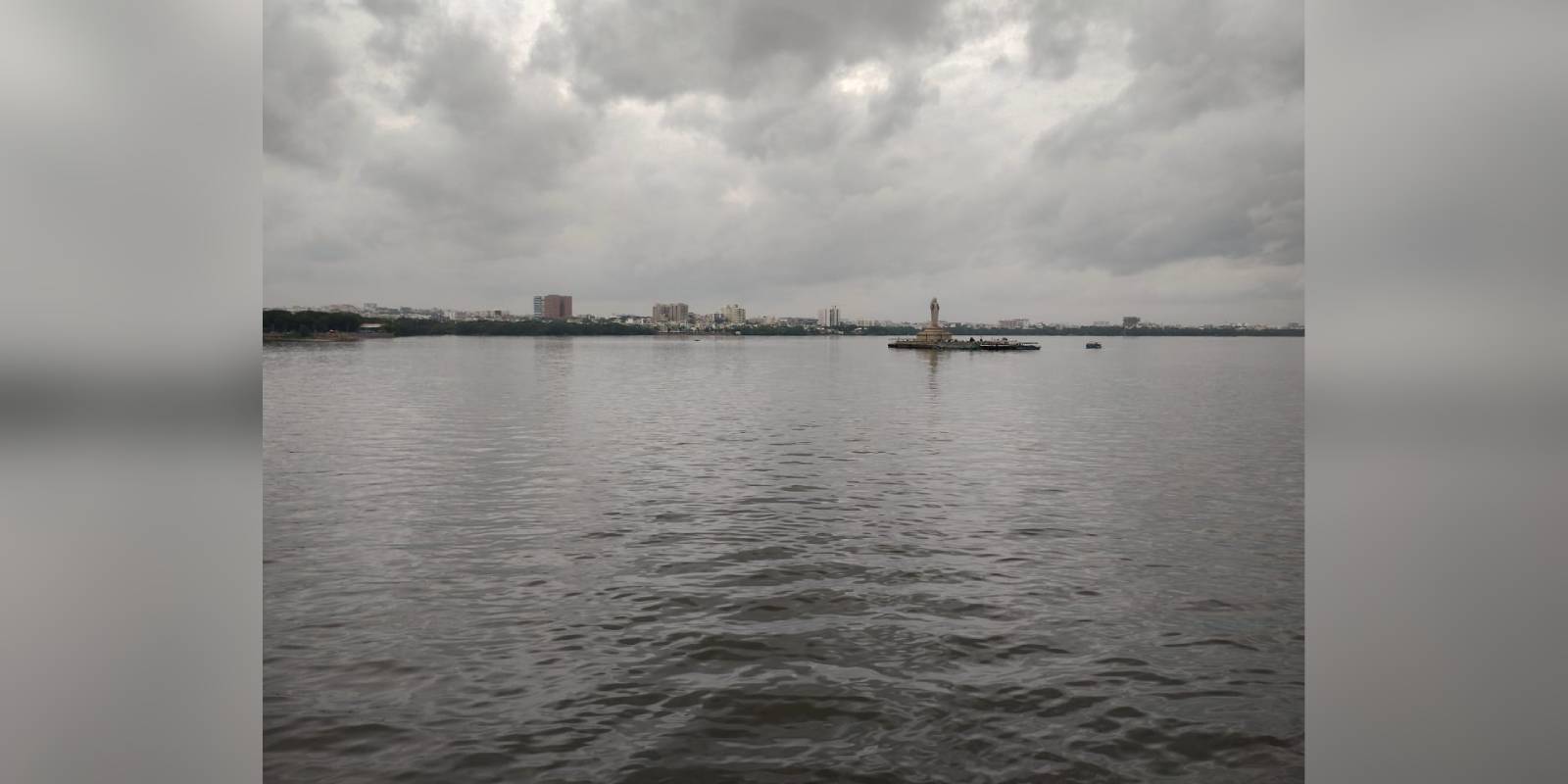According to official outlines, the plan will include a geo-referenced database of the stormwater drainage (SWD) network, supported by hydraulic and hydrologic modelling to analyse current capacity and vulnerabilities.
Published Aug 10, 2025 | 12:57 PM ⚊ Updated Aug 10, 2025 | 12:57 PM

The Hussain Sagar lake filled with rain water. (Sai Charan Sana/ South First)
Synopsis: The Telangana government is rushing to put together a long-overdue plan aimed at shielding Hyderabad from the kind of havoc caused by torrential rains. The plan is intended to address chronic weaknesses in the city’s stormwater management systems that have led to repeated urban flooding, water pollution, and overstressed infrastructure.
As dark, rain-bearing clouds continue to hover over Hyderabad’s skyline, the Telangana government is rushing to put together a long-overdue plan aimed at shielding the city from the kind of havoc that was caused by torrential rains which descended without any warning.
Hyderabad suffered floods of near-epic proportions in 2020, but successive governments, both then and now, have failed to take consistent follow-up measures to prevent similar disasters. Each monsoon has brought reminders of that lapse, yet the momentum for a comprehensive flood-prevention strategy has always seemed to dissipate once the skies cleared.
In recent years, one initiative — the Hyderabad Disaster Response and Assets Protection Agency (HYDRAA) — was set up to reclaim and restore the city’s lakes from encroachers.
While this is an important step in the larger flood-management puzzle, it is only one piece of a much bigger problem. HYDRAA’s work, often undertaken under political and social pressure, has made modest headway in certain areas. But as the latest spell of rains showed, many other aspects of flood management have been left hanging for too long.
Shaken into action by the heavy rains that pounded the city over the past week, the state government, through Government Order (G.O) No. 391, directed the Greater Hyderabad Municipal Corporation (GHMC) to prepare a Comprehensive and Integrated Storm Water Master Plan for the Telangana Core Urban Region (TCUR).
The plan is intended to address chronic weaknesses in the city’s stormwater management systems that have led to repeated urban flooding, water pollution, and overstressed infrastructure.
That such a master plan is only now being initiated — and not before the monsoon set in — has raised eyebrows. Critics say it should have been drawn up and implemented well ahead of the rainy season, not as a reactive measure in the midst of flooding. Nevertheless, the government insists that the work will be put on a fast track.
The TCUR, encompassing the state’s economic, social, and cultural nerve centre, includes major industries, sprawling IT hubs, and key commercial districts that together contribute significantly to Telangana’s Gross State Domestic Product (GSDP).
Its high population density is matched by a complex hydrological network: The Musi River and its tributaries, and lakes such as Hussain Sagar and Osman Sagar. The master plan will cover stormwater systems not only within GHMC limits but also in the surrounding districts.
According to official outlines, the plan will include a geo-referenced database of the stormwater drainage (SWD) network, supported by hydraulic and hydrologic modelling to analyse current capacity and vulnerabilities. It will focus on identifying flood-prone areas, redesigning drainage systems, and applying best management practices (BMPs) to reduce stormwater pollution, thereby safeguarding aquatic ecosystems in lakes and rivers.
Green infrastructure solutions — including rain gardens, bioswales, and permeable pavements — are to be integrated into the city’s layout to manage runoff while improving urban aesthetics.
A comprehensive survey of the TCUR’s hydrological systems, from lakes and nalas to catchment areas, will form the basis of the plan. GHMC has been tasked with inviting Expressions of Interest from qualified consultants and firms to take on the project.
However, major challenges loom. Because TCUR extends beyond GHMC’s jurisdiction, the plan will require coordination among multiple administrative bodies — a task complicated by a notoriously layered bureaucracy. This complexity has, in the past, stalled decision-making and delayed execution.
Budget constraints present another serious obstacle: The state government is grappling with financial strain, and GHMC’s own fiscal health has long been shaky.
Even the ongoing efforts by HYDRAA to remove encroachments from lake beds and nalas remain fraught with difficulty. Political interference, combined with pushback from those who have built homes or businesses on illegally occupied land, makes the process contentious.
In many cases, politicians sided with encroachers to protect their voter base, further entrenching the problem.
Environmental factors add another unpredictable layer. Ecological disturbances on a macro scale are believed to be making rainfall patterns harder to forecast, with climate change producing erratic monsoon behaviour. This uncertainty could complicate planning, raising the risk that funds might be directed to areas that may not face the same threats in the future.
Given the track record of successive governments in executing large-scale infrastructure projects, scepticism surrounds the latest move. Many citizens and experts question whether the Comprehensive Storm Water Master Plan for TCUR will be ready in time, how quickly it will be implemented, and whether it will survive changes in political priorities.
Still, the plan, if executed effectively, has the potential to transform Hyderabad’s resilience to extreme weather. It could enhance the city’s livability, protect its economic hubs, and preserve its natural water systems.
However, as the adage goes, the proof of the pudding is in the eating. For the master plan to succeed, it will require not only careful design but also effective coordination among agencies, adequate funding, and disciplined, time-bound execution.
For now, as Hyderabad continues to slosh through flooded streets and braces for more rain, the city’s future flood defences remain on paper. Whether the master plan can move from drawing board to reality before the next monsoon will be the real test — one the city can ill afford to fail.
(Edited by Muhammed Fazil.)
